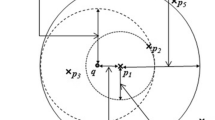Abstract
A new method for octree neighbor finding is proposed, named during Model Construction using Parental Neighboring rule (MCPN). Our proposed method finds and stores all neighbors of all leaf nodes during tree model construction, unlike majority of previous neighbor finding methods in which constructed tree model is the input of neighbor finding algorithm. Considering Parental Neighboring Rule (PNR), neighbor finding during tree model construction causes no increase in its time complexity class. The proposed method finds all neighbors of a node in 26 possible directions regardless of their size. Experimental results show that both in quadtrees and octrees, MCPN’s needed time to find and store all neighbors of all leaf nodes plus tree model construction time, relative to tree model construction time alone, converges to one as the level of tree increases. Also MCPN outclasses the latest constant time neighbor finding method for quadtrees proposed by Aizawa and Tanaka.























Similar content being viewed by others
References
Payeur, P. (2004). An optimized computational technique for free space localization in 3-D virtual representations of complex environments. In Proceedings of the 2004 IEEE Virtual Environment, Human-Computer Interfaces, and Measurement Systems, VECIMS, 2004. Boston.
Samet, H. (1989). Neighbor finding in images represented by octrees. Computer Vision, Graphics, and Image Processing, 46(3), 367–386.
Kim, J., & Lee, S. (2009). Fast neighbor cells finding method for multiple octree representation. In 2009 IEEE International Symposium on Computational Intelligence in Robotics and Automation (CIRA) (540–545). Daejeon.
Goerzen, C., Kong, Z., & Mettler, B. (2010). A survey of motion planning algorithms from the perspective of autonomous UAV guidance. Journal of Intelligent Robotic Systems, 57, 65–100.
Schrack, G. (1992). Finding neighbors of equal size in linear quadtrees and octrees in constant time. Computer Vision, Graphics, and Image Processing: Image Understanding, 55(3), 231–239.
Gargantini, I. (1982). Linear oct-trees for fast processing of three-dimensional objects. Computer Graphics and Image Processing, 20, 365–374.
Voros, J. (2000). A strategy for repetitive neighbor finding in octree representations. Image and Vision Computing, 18, 1085–1091.
Klinger, A., & Rhodes, M. (1979). Organization and access of image data by areas. In IEEE Pallem Analysis and Machine Intelligence I (pp. 50–60).
Payeur, P. (2006). A computational technique for free space localization in 3-D multi-resolution probabilistic environment models. Instrumentation and Measurement, 50(5), 1734–1746.
Yoder, R., Bloniarz, P. (2006). A practical algorithm for computing neighbors in quadtrees, octrees, and hyperoctrees. In International Conference on Modeling, Simulation and Visualization (249–255), Las Vegas: CSREA Press.
Aizawa, K., & Tanaka, S. (2009). A constant-time algorithm for finding neighbors in quadtrees. IEEE Transactions on Pattern Analysis and Machine Intelligence, 31(7), 1178–1183.
Aizawa, K., Motomura, K., Kimura, S., Kadowaki, R., & Fan J. (2008). Constant time neighbor finding in quadtrees: An experimental result. In ISCCSP 2008. Malta.
Hunter, G., & Steiglitz, K. (1979). Operations on images using quad trees. In IEEE Transactions on Pallem Analysis and Machine Intelligence I, (pp. 145–163).
Karimi, J., & Pourtakdoust, S. H. (2013). Optimal maneuver-based motion planning over terrain and threats using a dynamic hybrid PSO algorithm. Aerospace Science and Technology, 26, 60–71.
Jun, M., D’Andrea, R. (2003). Path planning for unmanned aerial vehicles in uncertain and adversarial environments. In Cooperative control: models, applications and algorithms (pp. 95–110). New york: Springer.
Author information
Authors and Affiliations
Corresponding author
Rights and permissions
About this article
Cite this article
Namdari, M.H., Hejazi, S.R. & Palhang, M. MCPN, Octree Neighbor Finding During Tree Model Construction Using Parental Neighboring Rule. 3D Res 6, 29 (2015). https://doi.org/10.1007/s13319-015-0060-9
Received:
Revised:
Accepted:
Published:
DOI: https://doi.org/10.1007/s13319-015-0060-9




